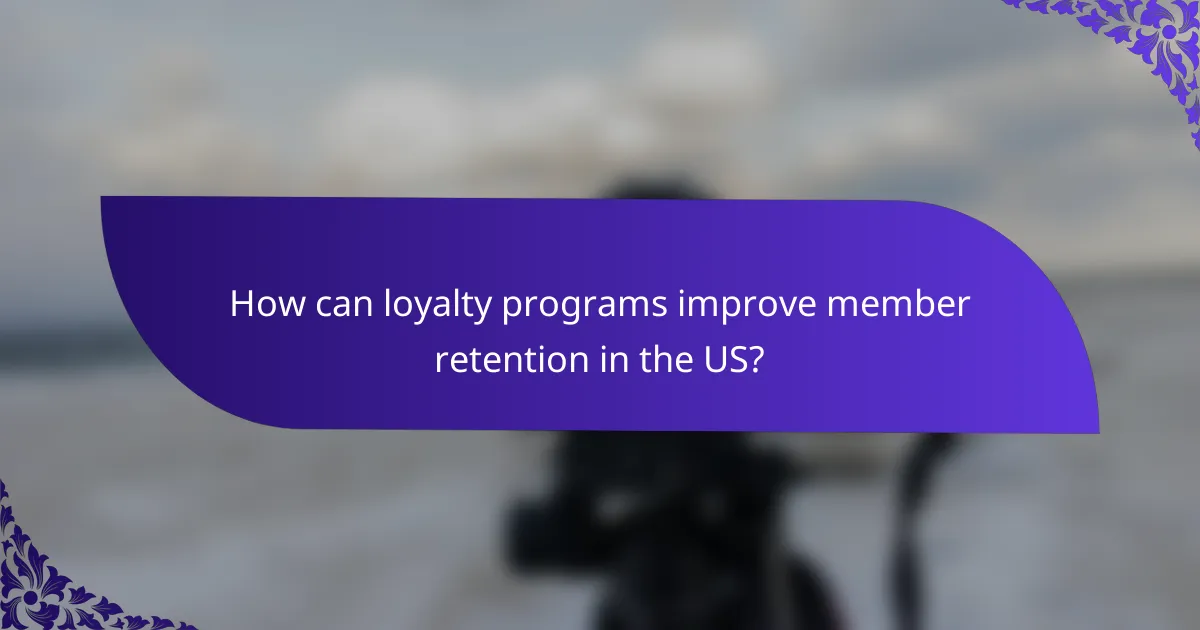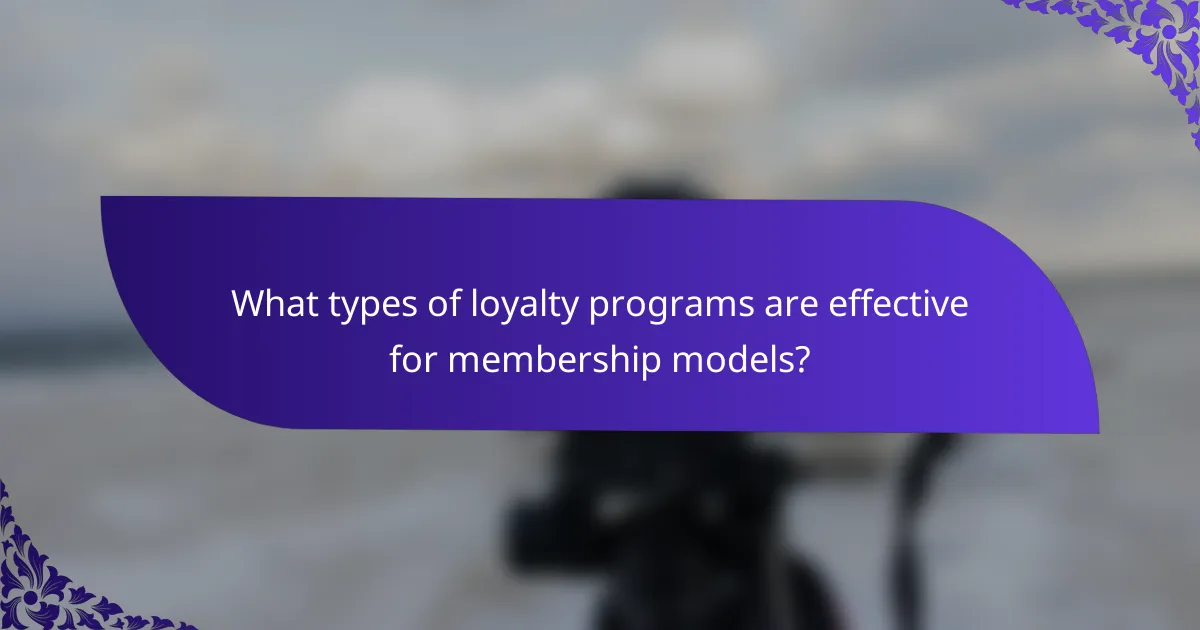Loyalty programs play a crucial role in enhancing member retention by creating stronger connections between customers and brands. By implementing effective strategies such as points-based systems and tiered rewards, businesses can incentivize repeat purchases and foster ongoing engagement, ultimately cultivating a loyal customer base.

How can loyalty programs improve member retention in the US?
Loyalty programs can significantly enhance member retention in the US by fostering a deeper connection between customers and brands. These programs incentivize repeat purchases and engagement, ultimately leading to a more loyal customer base.
Increased customer engagement
Loyalty programs boost customer engagement by offering rewards for frequent interactions. Members are more likely to participate in promotions, surveys, and social media activities when they know they can earn points or discounts.
For instance, a coffee shop might offer a free drink after a certain number of purchases, encouraging customers to return more often. This consistent engagement keeps the brand top-of-mind and strengthens the relationship with members.
Enhanced customer satisfaction
Customer satisfaction often improves with loyalty programs as members feel valued through exclusive offers and personalized experiences. When customers receive rewards tailored to their preferences, they perceive a higher level of service and attention.
For example, a retail store might send personalized discounts based on past purchases, making members feel appreciated and understood. This satisfaction can lead to positive word-of-mouth and increased referrals, further enhancing retention.
Higher lifetime value
Loyalty programs can lead to a higher customer lifetime value (CLV) by encouraging repeat purchases and increasing the average transaction size. Members who are engaged in a loyalty program tend to spend more over time compared to non-members.
For instance, a subscription service might offer tiered rewards that incentivize customers to upgrade their plans for better benefits. This strategy not only retains existing members but also attracts new ones who see the value in joining the program.

What types of loyalty programs are effective for membership models?
Effective loyalty programs for membership models include points-based systems, tiered rewards programs, and subscription discounts. Each type offers unique benefits and can significantly enhance member retention by encouraging ongoing engagement and spending.
Points-based systems
Points-based systems reward members with points for every purchase or interaction, which can later be redeemed for discounts, products, or exclusive services. This model encourages frequent transactions as members strive to accumulate points.
To implement a points-based system, establish a clear conversion rate, such as one point per dollar spent. Consider offering bonus points for specific actions, like signing up or referring friends, to boost initial engagement.
Tiered rewards programs
Tiered rewards programs create levels of membership that offer increasing benefits based on spending or engagement. Members progress through tiers, unlocking better rewards as they reach higher levels, which fosters loyalty and motivates higher spending.
When designing a tiered program, define the criteria for each level clearly. For example, members could start at a basic level and advance to silver or gold after spending certain amounts, such as $500 or $1,000 annually. This structure encourages members to aim for higher tiers for better rewards.
Subscription discounts
Subscription discounts provide members with reduced prices or exclusive offers in exchange for a recurring fee. This model not only enhances retention but also ensures a steady revenue stream for the business.
To effectively implement subscription discounts, consider offering a trial period or introductory pricing to attract new members. For instance, a monthly subscription might offer a 10% discount on all purchases, incentivizing members to commit long-term while enjoying savings.

What are the key features of successful loyalty programs?
Successful loyalty programs typically include personalization options, easy redemption processes, and multi-channel accessibility. These features enhance member engagement and retention, making customers feel valued and understood.
Personalization options
Personalization is crucial for loyalty programs as it allows businesses to tailor rewards and communications to individual preferences. By analyzing customer data, companies can offer customized rewards that resonate with their members, such as personalized discounts or exclusive offers based on past purchases.
Consider implementing tiered rewards that reflect customer loyalty levels. For example, a program might offer basic discounts for new members and exclusive experiences for long-term customers, fostering a sense of belonging and appreciation.
Easy redemption processes
An effective loyalty program must have a straightforward redemption process to encourage participation. Complicated procedures can frustrate members and deter them from engaging with the program. Aim for a seamless experience where customers can easily redeem points or rewards through a user-friendly interface.
For instance, allowing members to redeem points online or in-store without excessive restrictions can significantly enhance satisfaction. Clearly communicate the redemption options and ensure that they are accessible across various platforms.
Multi-channel accessibility
Multi-channel accessibility ensures that customers can interact with the loyalty program through various platforms, such as mobile apps, websites, and physical stores. This flexibility allows members to engage with the program in a way that suits their lifestyle, increasing overall participation.
To maximize accessibility, consider integrating your loyalty program with social media platforms or email marketing. This approach can help reach a broader audience and provide multiple touchpoints for customers to earn and redeem rewards, enhancing their overall experience.

How to design a loyalty program that appeals to members?
To design a loyalty program that resonates with members, focus on understanding their needs and preferences while offering meaningful rewards. A well-structured program can enhance member retention by fostering a sense of value and connection.
Understand member preferences
Understanding member preferences is crucial for creating a successful loyalty program. Conduct surveys or focus groups to gather insights on what members value most, whether it’s discounts, exclusive access, or personalized experiences.
Utilize data analytics to track member behavior and spending patterns. This information can help tailor rewards that align with their interests, increasing engagement and satisfaction.
Incorporate feedback mechanisms
Incorporating feedback mechanisms allows members to voice their opinions about the loyalty program. Regularly solicit feedback through online polls or direct communication, and ensure that members feel heard and valued.
Act on the feedback received to make necessary adjustments to the program. This responsiveness can enhance member loyalty and demonstrate that their input directly influences the program’s evolution.
Align rewards with member values
Aligning rewards with member values is essential for fostering loyalty. Consider offering rewards that resonate with members’ lifestyles, such as eco-friendly products or community-focused initiatives, which can enhance their emotional connection to the program.
Evaluate the types of rewards offered and ensure they reflect the interests and values of your target audience. This alignment can significantly boost participation and retention rates, as members feel their values are recognized and rewarded.

What metrics should be used to measure loyalty program success?
To effectively measure loyalty program success, focus on key metrics such as member retention rates, engagement levels, and redemption rates. These indicators provide insights into how well the program retains customers, keeps them active, and encourages them to redeem rewards.
Member retention rates
Member retention rates indicate the percentage of customers who continue to engage with your loyalty program over a specific period. A higher retention rate suggests that your program is effectively fostering customer loyalty and satisfaction.
To calculate retention rates, divide the number of members who remain active by the total number of members at the start of the period. Aim for a retention rate above 60% to ensure your program is meeting customer needs.
Engagement levels
Engagement levels measure how actively members participate in the loyalty program. This can include tracking the frequency of purchases, interactions with promotional content, and participation in program events. Higher engagement often correlates with stronger loyalty.
Consider using metrics such as the average number of transactions per member or the percentage of members who redeem rewards within a certain timeframe. Targeting an engagement level where at least 30-50% of members are actively participating can indicate a healthy program.
Redemption rates
Redemption rates reflect the percentage of earned rewards that members actually redeem. A high redemption rate suggests that members find value in the rewards offered, while a low rate may indicate that the rewards are not appealing or accessible.
To calculate redemption rates, divide the number of rewards redeemed by the total number of rewards issued. Aim for a redemption rate of 20-30% to ensure that your rewards are enticing enough to encourage member participation.


